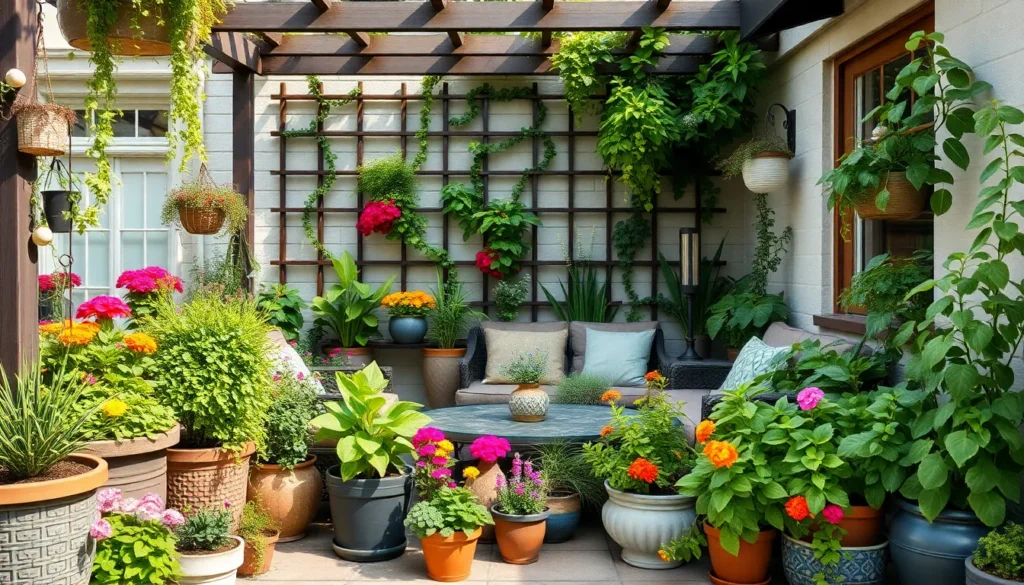We’ve all dreamed of transforming our patios into stunning outdoor retreats that rival the most beautiful garden magazines. The secret isn’t expensive furniture or elaborate lighting – it’s the strategic use of plants that can completely revolutionize your outdoor space.
Plants offer the perfect solution for creating privacy, adding color, and establishing distinct zones on your patio. Whether you’re working with a sprawling deck or a cozy balcony, the right plant combinations can make your space feel like a luxurious extension of your home. From cascading vines that soften hard edges to statement trees that provide natural shade, plants deliver both beauty and functionality.
We’ll show you how to select plants that thrive in your exact conditions while creating the ambiance you’ve always wanted. You don’t need a green thumb or a massive budget – just the right knowledge to make smart choices that’ll transform your patio into your favorite room of the house.
Create a Stunning Container Garden Display
Container gardens transform any patio space into a vibrant outdoor showcase without requiring permanent planting beds. We’ll show you how to arrange plants in pots that create maximum visual impact while accommodating your space constraints.
Choose the Right Pot Sizes and Materials
Large containers measuring 18-24 inches wide work best for creating focal points in your patio container display. Terra cotta pots provide excellent drainage and develop an attractive weathered patina over time. Ceramic containers offer durability and come in many colors to match your patio’s style.
Medium pots ranging from 12-16 inches suit most flowering plants like petunias, marigolds, and begonias. We recommend choosing containers that are at least twice the width of your plant’s root ball. Resin planters weigh less than ceramic options while maintaining their appearance through multiple seasons.
Small 6-10 inch pots work perfectly for herbs and compact plants such as succulents, small ferns, and trailing varieties. Metal containers heat up quickly in direct sunlight and may damage sensitive root systems. Wooden planters create a natural look but require regular sealing to prevent rot and decay.
Mix Textures with Different Plant Types
Combine smooth-leafed plants with textured foliage to create visual contrast in your container arrangements. Hostas provide broad, glossy leaves that pair beautifully with the fine, needle-like texture of ornamental grasses. We suggest grouping plants with similar water requirements in the same containers.
Spiky plants like yucca or snake plants add architectural interest when placed alongside rounded, soft plants such as lamb’s ear or dusty miller. Trailing plants including ivy, sweet potato vine, and bacopa soften container edges and create flowing lines. Mix flowering plants with foliage plants to maintain color throughout the growing season.
Vary leaf shapes by combining linear, round, and heart-shaped varieties in your container displays. Coleus offers colorful foliage in many patterns and thrives in partial shade conditions. We recommend selecting plants with different growth habits to maximize your container’s visual appeal.
Layer Heights for Visual Interest
Tall plants measuring 2-4 feet should anchor your container arrangements at the back or center depending on your viewing angle. Ornamental grasses, small shrubs, and upright perennials create excellent height anchors. Position these thriller plants first before adding smaller companions.
Medium-height plants ranging from 12-18 inches fill the middle layer of your container design. Flowering annuals like zinnias, cosmos, and salvia work well as filler plants in this category. We suggest choosing plants that won’t overshadow shorter varieties while complementing your tall anchor plants.
Low-growing plants under 8 inches complete your layered display by cascading over container edges or filling gaps between taller plants. Spillers such as trailing petunias, lobelia, and creeping jenny create a finished look. Group containers of varying heights to extend the layering effect across your entire patio space.
Design a Living Privacy Screen
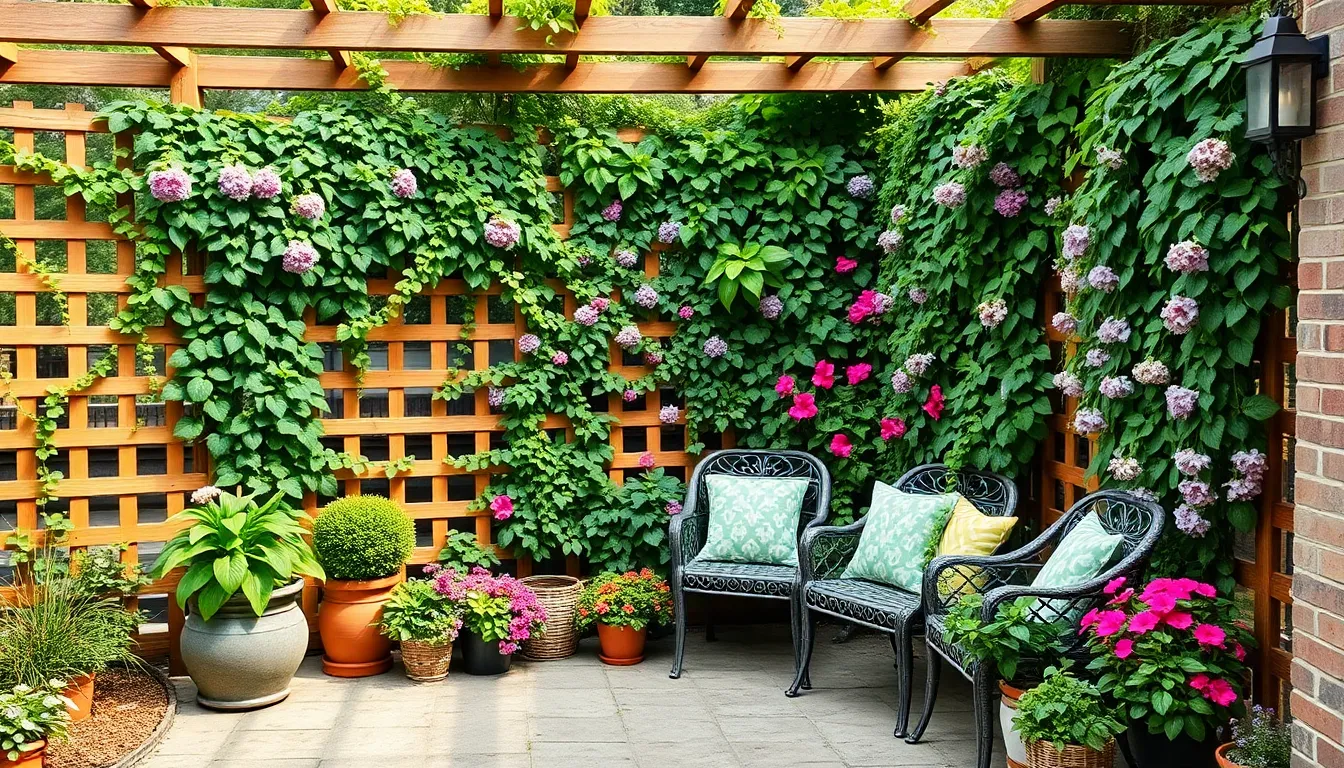
Creating privacy on your patio doesn’t require expensive fencing or bulky structures. Plants offer a natural and beautiful solution that transforms your outdoor space while blocking unwanted views.
Select Fast-Growing Climbing Plants
Choose vigorous climbers that establish quickly and provide immediate screening results. Ivy, clematis, and climbing roses are excellent options that rapidly cover vertical surfaces and create dense green barriers.
Maximize your vertical space by selecting plants that grow upward rather than outward. These climbing varieties work perfectly for smaller patios where ground space is limited but privacy is still essential.
Consider evergreen climbers like English ivy or climbing jasmine for year-round coverage. Deciduous options such as clematis provide stunning seasonal flowers while maintaining good screening density during growing months.
Plant multiple varieties to ensure consistent coverage if one plant struggles or needs seasonal maintenance. This redundancy approach guarantees your privacy screen remains effective throughout the year.
Install Trellises and Support Structures
Install sturdy trellises before planting to give climbing plants immediate support and direction. Wooden lattice panels or metal grid systems work exceptionally well for most climbing varieties.
Position arbors and pergolas strategically to create overhead screening along with vertical coverage. These structures serve dual purposes as decorative features and functional plant supports.
Choose materials that complement your patio’s existing design aesthetic. Cedar trellises offer natural warmth while powder-coated metal provides modern durability and clean lines.
Space support structures appropriately to accommodate mature plant spread. Most climbing plants need 3-4 feet between major support points to develop proper coverage density.
Combine Different Screening Plants
Layer plants by height to create a natural privacy gradient that feels organic rather than wall-like. Tall shrubs like Japanese maples form the upper canopy while ornamental grasses provide mid-level screening.
Mix textures and foliage types to add visual interest beyond simple privacy function. Combine broad-leafed shrubs with feathery grasses and dense evergreen plantings for ever-changing seasonal appeal.
Select complementary plants that thrive in similar growing conditions to simplify maintenance. Grouping shade-tolerant varieties together or sun-loving plants in bright areas ensures healthier growth.
Create depth by staggering plant placement rather than arranging everything in straight lines. This natural positioning allows light to filter through while maintaining effective privacy coverage.
Build a Vertical Garden Wall
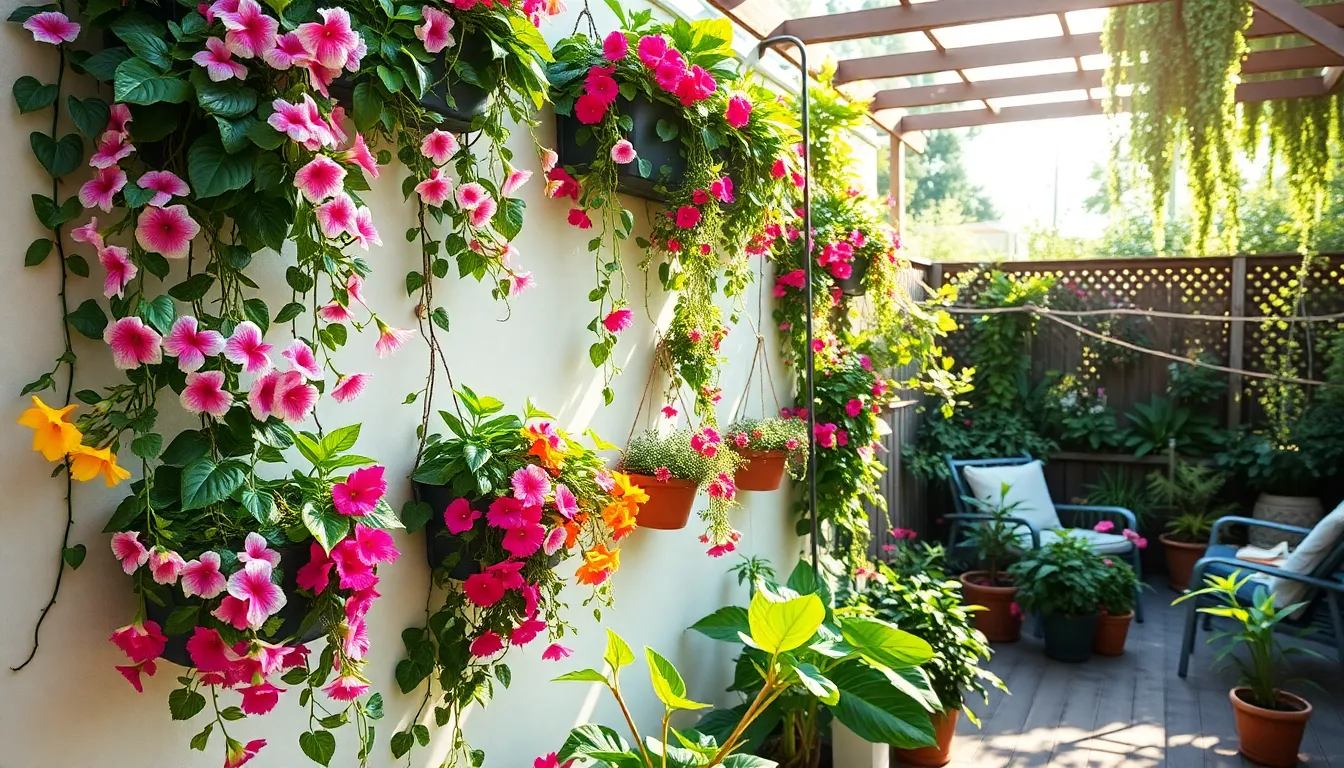
Vertical garden walls maximize space while transforming blank patio walls into living art pieces. We’ll explore how to create stunning vertical displays that bring lush greenery to eye level without cluttering your floor space.
Install Wall-Mounted Planters
Wall-mounted planters create structured vertical gardens that work perfectly for small patios where ground space is precious. We recommend using modular wall-mounted systems or creating DIY pallet gardens for a more rustic approach. Choose durable materials like cedar, metal, or weather-resistant plastic that can withstand outdoor conditions year-round.
Position planters at varying heights to create visual interest and ensure each plant receives adequate light. We suggest spacing them 12-18 inches apart vertically to allow trailing plants room to cascade naturally. Install proper drainage systems in each planter to prevent water damage to your walls and ensure healthy plant growth.
Mix different sized planters on your wall to accommodate various plant types and create a ever-changing display. Large planters work best for statement plants like ferns or small shrubs, while smaller units are perfect for herbs, succulents, or compact flowering varieties.
Choose Trailing and Cascading Plants
Trailing plants add softness and movement to rigid vertical structures, creating a flowing waterfall effect that softens hard patio surfaces. Star jasmine climbs beautifully up trellises while its fragrant white flowers cascade down, bringing both scent and visual appeal to your vertical garden.
Select plants like lantana and hibiscus for their vibrant blooms and natural trailing habit that spills gracefully from elevated planters. Scaevola (fan flower) produces masses of small purple or white blooms that create stunning cascading displays throughout the growing season. Sweet potato vine offers dramatic foliage in colors ranging from chartreuse to deep purple, providing excellent contrast against flowering plants.
Combine trailing flowering plants with cascading succulents like echeverias and sempervivums for varied textures and low maintenance appeal. These drought-tolerant options reduce watering frequency while still providing visual interest through their unique forms and occasional colorful blooms.
Create Patterns with Color and Texture
Strategic color groupings transform random plant collections into cohesive vertical garden designs that complement your patio’s existing aesthetic. We recommend creating themed palettes that flow naturally from top to bottom of your vertical display.
Develop hot color schemes using red verbena, orange marigolds, and yellow sunflowers for energetic, bold statements that catch attention from across the patio. These warm tones work especially well on north-facing walls that receive less natural light throughout the day.
Design calming palettes with blue salvia, white bacopa, and gray-leafed licorice plant for serene vertical gardens that create peaceful atmospheres. These cooler tones are perfect for patios used primarily for relaxation and evening entertaining.
Mix tropical plants like croton petra with flowering varieties such as fuchsia or lavender to add vibrancy and exotic appeal to your vertical garden. Combine plants with different leaf shapes and flower sizes to create depth and visual texture that draws the eye upward along your living wall.
Establish Defined Plant Zones
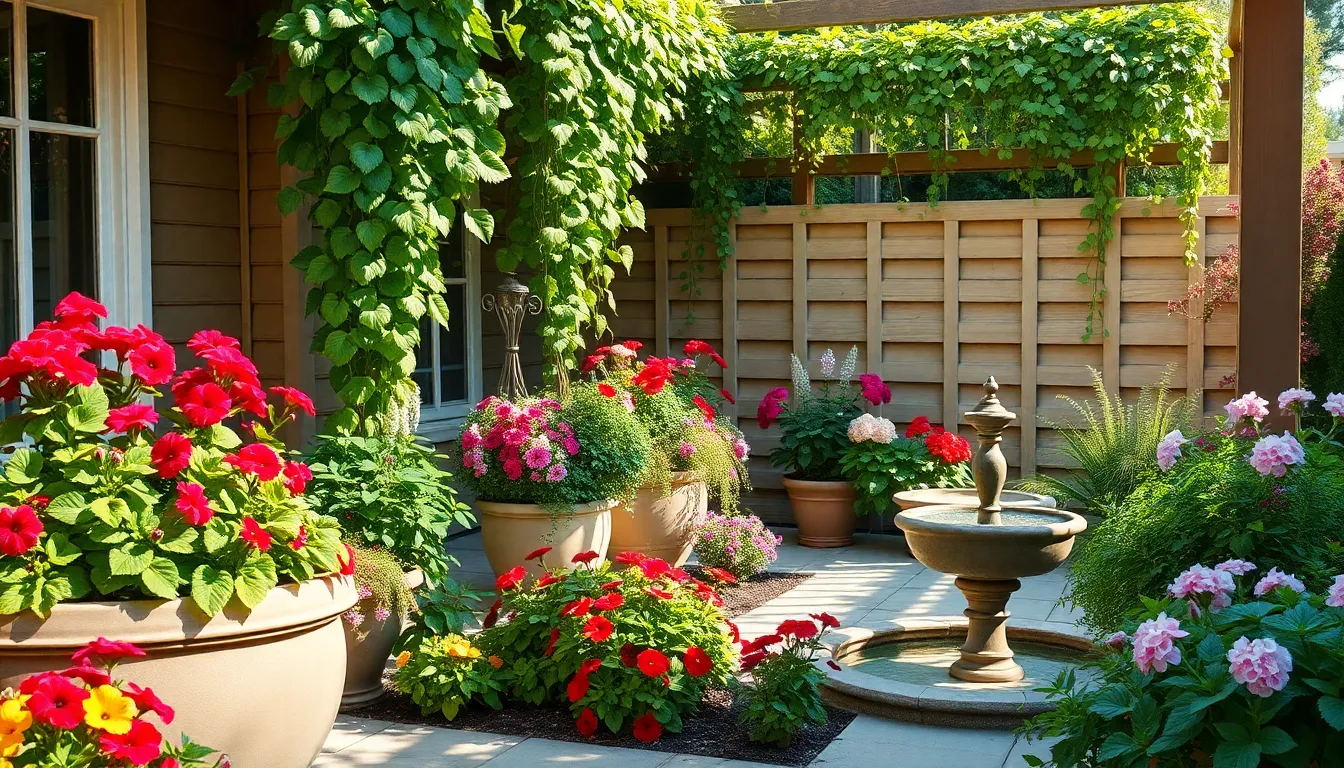
Creating distinct zones transforms your patio into an organized outdoor sanctuary where each plant serves a exact purpose. We’ll show you how to divide your space strategically for maximum visual impact and easier maintenance.
Designate Areas for Different Plant Types
Grouping plants by their function creates structure while making maintenance more manageable. We recommend dedicating one section to pollinator-friendly plants like butterfly bushes or verbena that attract wildlife and add natural movement to your space. Another zone can showcase colorful annuals such as petunias or lantana that provide consistent blooms throughout the growing season.
Mixing plant heights within each designated area adds depth and visual interest to your patio design. We suggest combining tall climbing plants with medium-sized flowering varieties and low-growing ground covers to create natural layers. This approach works especially well when you match plants that thrive in similar light conditions within each zone.
Consider creating themed areas based on plant characteristics or care requirements. We often see success with aromatic herb gardens clustered near seating areas where you can easily access fresh ingredients for cooking. Shade-loving plants work perfectly in corners or areas protected by overhangs where other varieties might struggle.
Use Planters to Create Boundaries
Planters serve as both functional containers and decorative elements that define different zones without permanent construction. We recommend using tall planters with climbing plants like ivy or clematis to create vertical boundaries around columns or patio edges. These living screens provide privacy while adding lush greenery to previously unused vertical space.
Stacking planters of varying sizes creates ever-changing layered effects that naturally separate areas. We suggest placing cascading plants in top containers while fuller, bushier varieties fill the lower planters. This technique works particularly well for creating transitions between different functional areas of your patio.
Strategic planter placement can guide foot traffic and create intimate conversation areas within larger patios. We often use clusters of medium and large containers to establish natural pathways while maintaining the organic feel of your outdoor space. Water features like fountains placed between planter groupings add sensory appeal while reinforcing zone boundaries.
Group Plants by Watering Needs
Organizing plants by their moisture requirements improves maintenance efficiency while ensuring optimal plant health. We recommend grouping drought-tolerant varieties like English ivy and butterfly bush separately from moisture-loving annuals such as petunias. This strategic separation prevents overwatering hardy plants while ensuring thirstier varieties receive adequate hydration.
Creating watering zones conserves resources and reduces the time you spend maintaining your patio garden. We suggest installing drip irrigation systems or soaker hoses for each zone based on exact plant needs. Plants requiring daily watering can be grouped near water sources or in easily accessible areas for convenient hand watering.
Climate zone compatibility plays a crucial role in successful plant groupings for watering efficiency. We always consider regional growing conditions when selecting plants, noting that butterfly bush thrives in USDA zones 5-9 while tropical varieties need protection in cooler climates. Clustering pots and containers instead of scattering them randomly creates more inviting compositions while simplifying your watering routine.
Add Fragrant Plants for Sensory Appeal
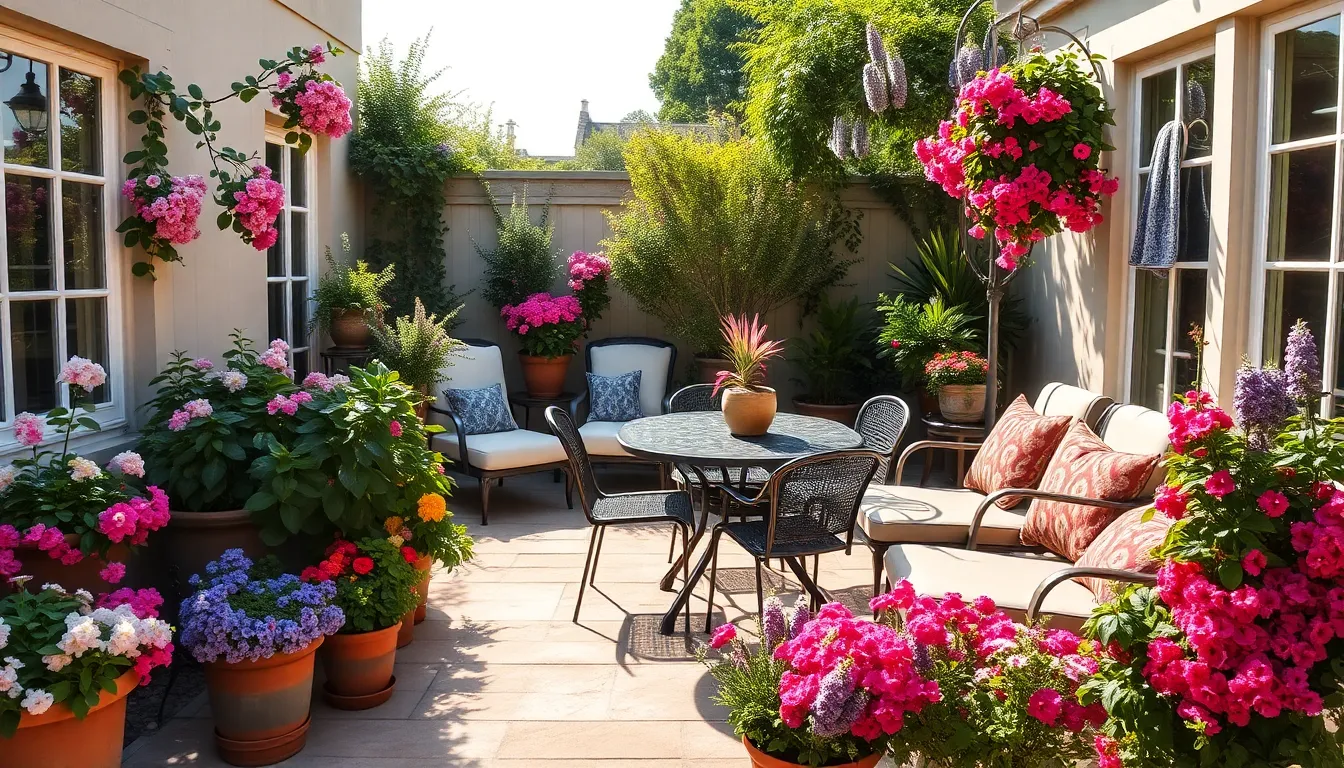
We transform our patios into truly immersive outdoor retreats by incorporating fragrant plants that engage multiple senses. Aromatic plants create layers of sensory experience that complement the visual beauty we’ve already established through strategic plant placement.
Select Aromatic Herbs and Flowers
Star jasmine delivers one of the most rewarding fragrant additions to our patio spaces. This low maintenance climber reaches up to 5 feet tall while producing intensely sweet blooms throughout the growing season. We position star jasmine near walls or trellises where it thrives in USDA zones 8 to 10, requiring only monthly fertilizing during the offseason for optimal summer growth.
English lavender provides both classic purple color and distinctive scent that works beautifully in container arrangements. Hardy across USDA zones 4 to 10, lavender adapts well to patio borders or mixed plantings with seasonal annuals. We find this versatile plant particularly effective when grouped in clusters of three or five pots.
Culinary herbs like rosemary, thyme, and mint offer dual benefits of fragrance and kitchen functionality. These aromatic herbs thrive in individual pots where we can easily harvest them while enjoying their natural scents. Fresh herbs release their oils when brushed against or when temperatures rise during sunny afternoons.
Position Fragrant Plants Near Seating Areas
Strategic placement near gathering spots maximizes the sensory impact of our aromatic plant selections. We cluster fragrant containers around dining tables, lounge chairs, and conversation areas where people naturally spend extended time. Close proximity ensures guests experience the pleasant scents during meals, relaxation, or entertaining.
Walkways and entrance points benefit from fragrant plant placement that welcomes visitors with natural aromatherapy. Low growing aromatic plants like lavender work perfectly along patio edges where foot traffic naturally brushes against them. We create natural scent zones by positioning taller fragrant plants like jasmine behind seating areas where evening breezes carry their perfume forward.
Consider Seasonal Blooming Schedules
Planning bloom times ensures continuous fragrance throughout our outdoor entertaining seasons. Lavender typically flowers during summer months while star jasmine blooms from late spring through early fall, creating overlapping periods of scent. We complement these flowering periods with evergreen aromatic herbs that provide year round fragrance even when not in bloom.
Seasonal layering involves selecting plants with staggered flowering schedules to maintain consistent sensory appeal. Early spring bulbs like hyacinths provide initial fragrance before our summer bloomers take over. Late season options such as autumn clematis extend aromatic interest well into fall months when we’re still enjoying outdoor spaces.
Winter interest comes from aromatic evergreen herbs and plants with fragrant foliage rather than flowers. Rosemary, sage, and other Mediterranean herbs maintain their scent profiles throughout cooler months, ensuring our patios retain sensory appeal during mild winter days perfect for outdoor relaxation.
Incorporate Edible Plants for Function
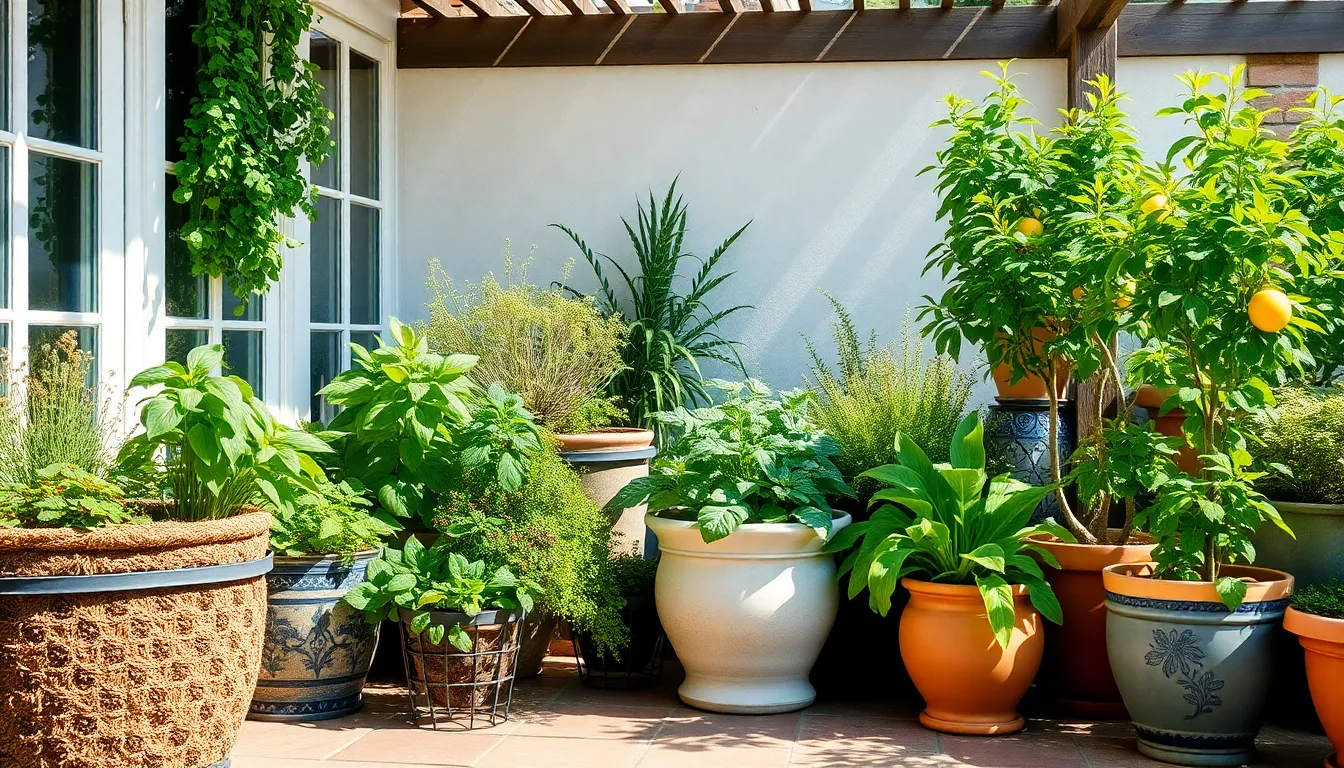
Edible landscaping transforms your patio into a productive outdoor space that combines beauty with utility. We’ll show you how to blend decorative and productive gardening techniques that make your patio both stunning and practical.
Plant Herbs in Accessible Containers
Herbs like basil, lavender, thyme, oregano, and rosemary thrive exceptionally well in patio containers where they’re easy to reach for daily cooking needs. Position these aromatic plants in medium-sized pots near your outdoor dining area or kitchen door for convenient harvesting during meal preparation.
Creating fragrant herb combinations enhances both visual appeal and culinary functionality. Mix ornamental peppers with herbs in decorative containers to build attractive arrangements that serve multiple purposes throughout the growing season.
Low-growing herbs such as thyme and oregano work beautifully as ground cover alternatives in larger planters. These spreading varieties fill container space efficiently while providing fresh seasonings for your outdoor cooking adventures.
Add Vegetable Planters to Your Design
Leafy vegetables including lettuce, Swiss chard, and kale adapt perfectly to container growing on patios where space is limited. Large coir-lined metal baskets accommodate these vegetables while adding rustic charm to your outdoor design scheme.
Patio tomatoes and pickling cucumbers maximize your harvest potential in vertical growing arrangements. Hanging baskets filled with trailing vegetable varieties create productive displays that don’t consume valuable floor space.
Raised bed systems work exceptionally well for organizing different vegetable types while maintaining easy access for harvesting. These elevated planters also improve drainage and soil conditions for optimal vegetable production throughout the growing season.
Include Fruit Trees in Large Pots
Fruit trees such as apples, pears, cherries, and citrus varieties create stunning focal points while producing fresh fruit for your family. These container-grown trees offer seasonal flowers in spring and colorful fruit displays during harvest time.
Large ceramic or wooden planters provide adequate root space for dwarf fruit tree varieties that stay compact for patio environments. Position these statement trees in corners or along patio edges where they won’t obstruct foot traffic but still command attention.
Container mobility allows you to relocate fruit trees based on seasonal sunlight patterns or weather protection needs. This flexibility proves invaluable during extreme temperatures or when redesigning your patio layout for different occasions.
Use Plants to Frame Your Patio Space
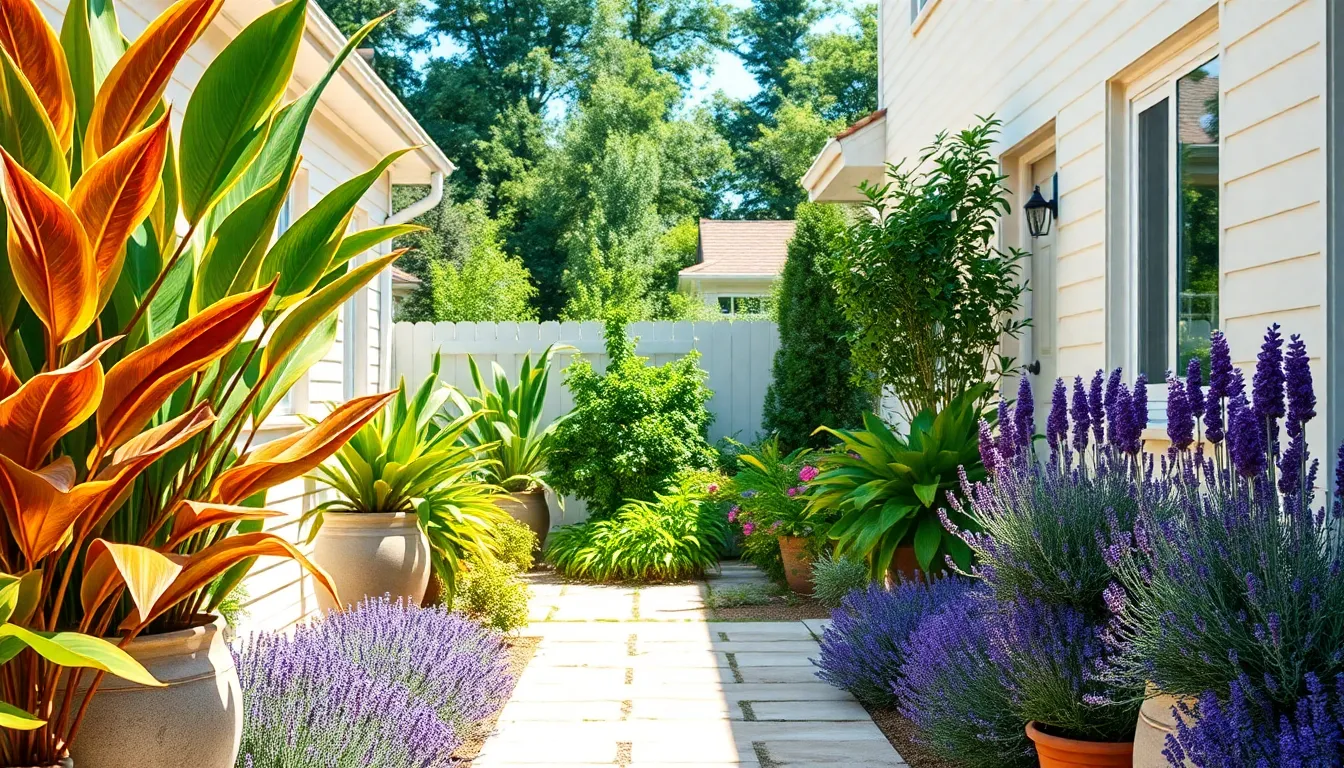
Strategic plant placement transforms your patio into a defined outdoor room that feels intentional and welcoming. We’ll show you how to use plants as natural architectural elements that create boundaries and structure.
Place Large Statement Plants at Corners
Corner positioning with bold plants adds instant structure and visual weight to your patio space. We recommend selecting plants that make a dramatic impact, such as Croton Petra with its vibrant, sun-loving foliage that brings both color and substantial size to these key positions.
Large tropical plants work exceptionally well as corner anchors because they create focal points that draw the eye naturally. Consider plants with broad leaves or striking colors that can hold their own against your patio’s hardscape elements.
Effective Corner Plant Characteristics:
| Plant Feature | Benefit | Best Examples |
|---|---|---|
| Height 3-4 feet | Creates visual boundaries | Croton Petra, Bird of Paradise |
| Bold foliage | Adds dramatic impact | Elephant ear, Fiddle leaf fig |
| Colorful leaves | Provides year-round interest | Coleus, Caladium |
Line Walkways with Decorative Planters
Walkway plantings guide visitors through your space while adding continuous beauty along pathways. We suggest using decorative planters filled with aromatic plants like English Lavender, which thrives in containers and releases pleasant scents as people brush past.
Container flexibility allows you to adjust your walkway design seasonally or as your plants grow. Choose planters that complement your patio’s style while providing adequate root space for healthy plant development.
Spacing your planters at regular intervals creates rhythm and flow along walkways. Mix different heights and textures within your planter selections to avoid monotony while maintaining visual cohesion.
Create Natural Borders with Plant Arrangements
Natural borders separate your patio from surrounding industry areas without requiring permanent construction. We recommend using fragrant climbing plants like Star Jasmine that can grow up trellises or pillars, providing vertical elements that define space boundaries.
Layered plantings work best for border creation, combining different heights and textures for maximum impact. Position taller plants like Star Jasmine behind shorter border plants such as Lavender to create depth and visual interest.
These plant arrangements serve dual purposes by adding beauty and function to your outdoor space. Climbing varieties can screen unwanted views while ground-level plantings provide continuous color and fragrance throughout the growing season.
Choose Low-Maintenance Plant Options
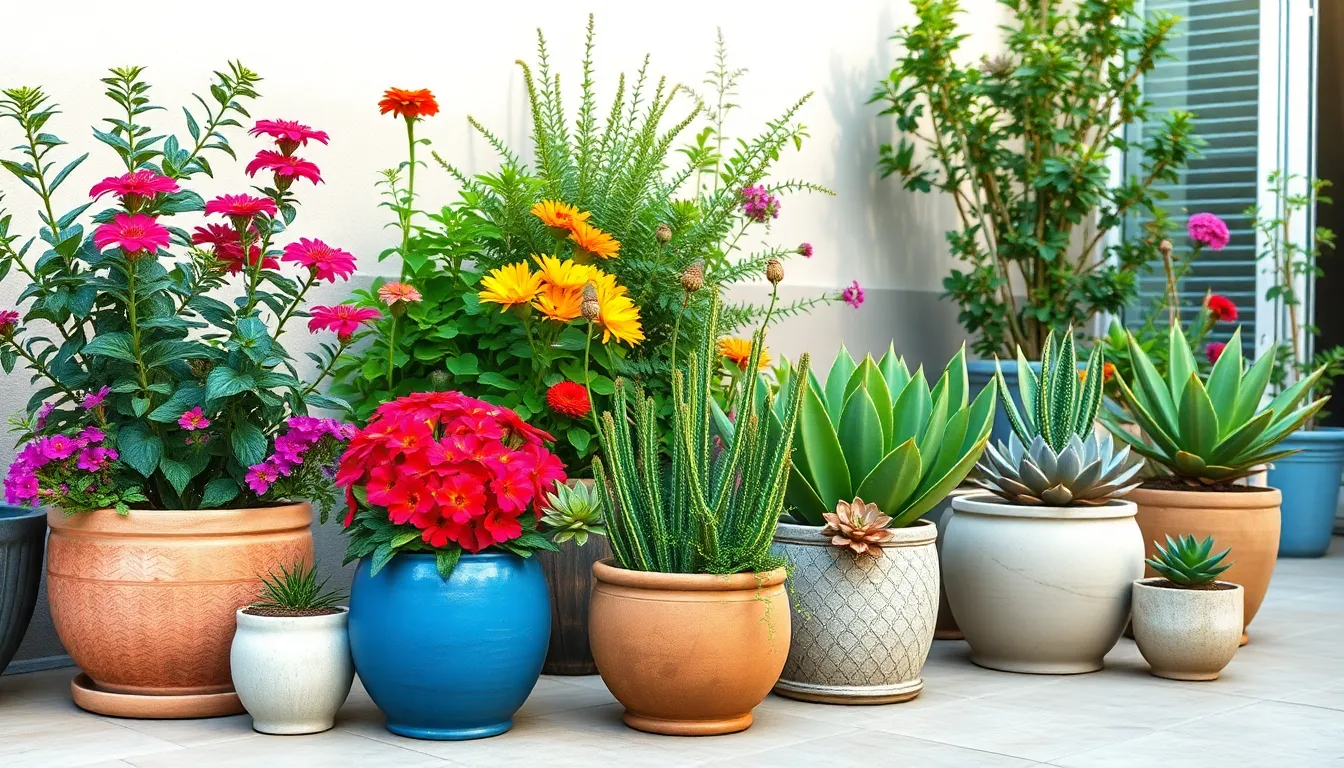
Building on your established patio design requires plants that won’t demand constant attention. We’ll focus on varieties that thrive with minimal intervention while delivering maximum visual impact for your outdoor space.
Select Drought-Tolerant Varieties
Lantana stands out as an exceptional drought-resistant choice that flourishes in sunny patio locations with minimal water requirements. This evergreen shrub produces vibrant flowers throughout the growing season while requiring only occasional watering once established. Cacti offer another excellent option for full-sun patios, needing minimal watering and providing architectural interest with their unique forms and textures.
Succulents excel in containers and deliver striking visual appeal while thriving in low-water conditions. These plants store water in their leaves, making them perfect for busy homeowners who travel frequently or prefer weekend-only maintenance routines. Mediterranean herbs like rosemary and thyme naturally resist drought conditions while adding culinary value to your patio garden setup.
Pick Plants Suited to Your Climate Zone
Cherry tomatoes demonstrate how climate-appropriate plant selection creates successful patio gardens, particularly in warm zones like Florida where they thrive with 4-6 hours of daily sunlight. Understanding your exact climate zone helps you choose plants that naturally flourish without extensive care modifications or seasonal protection measures.
Researching local growing conditions ensures your selected plants will adapt successfully to temperature fluctuations and seasonal changes in your area. Culinary herbs adapt well across various climate zones, but matching their exact light and temperature preferences to your local environment guarantees healthier growth patterns. Native plants often represent the best climate-suited options since they’ve evolved to thrive in your region’s natural conditions.
Opt for Perennials Over Annuals
Perennials return year after year, eliminating the expense and effort of annual replanting while building long-term value in your patio investment. Common sage exemplifies an ideal perennial choice that adapts well to container growing while providing both ornamental and culinary benefits throughout multiple seasons.
Many perennial varieties like lantana establish strong root systems that become increasingly drought-tolerant over time, reducing your watering responsibilities as plants mature. While impatiens are technically annuals, their exceptional drought resistance and prolific blooming make them worthwhile for seasonal color enhancement in shadier patio areas where perennial options might be limited.
Perennial herbs including oregano and thyme offer the dual advantage of returning annually while providing fresh ingredients for outdoor cooking and entertaining activities.
Combine Plants with Decorative Elements
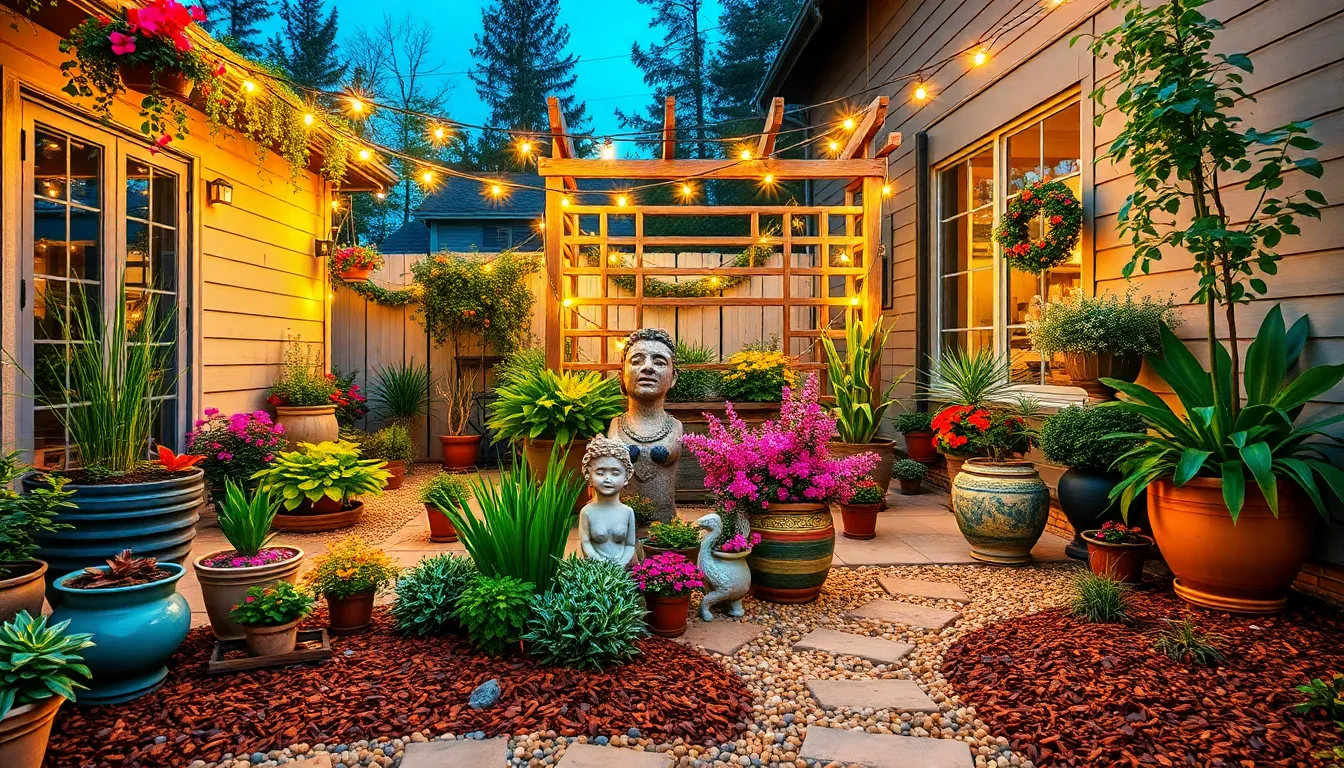
Pairing plants with decorative elements creates visual depth and transforms your patio into a cohesive outdoor living space. We’ll explore how strategic combinations of greenery and decorative pieces maximize both function and beauty.
Integrate Lighting Around Plant Displays
Lighting around plant arrangements extends your patio’s usability into evening hours while highlighting natural beauty. String lights draped through tall planters or wrapped around trellis structures create warm ambiance that makes foliage appear magical after dark. Solar-powered garden stakes positioned between container groupings provide gentle illumination without requiring electrical connections.
Lanterns placed at varying heights near plant displays add layers of warm light that complement your greenery’s textures. We recommend positioning battery-operated LED spotlights to uplight statement plants like large palms or architectural succulents, creating dramatic shadows against patio walls. This strategic lighting placement transforms your plant displays into captivating focal points that draw attention throughout the evening.
Add Garden Art Between Plant Groupings
Garden art introduces personality and visual interest while breaking up expanses of greenery with unique shapes and textures. Sculptures, decorative stakes, or wind chimes positioned between plant groupings create conversation starters that reflect your personal style. Metal garden art pieces work particularly well with Mediterranean herbs like lavender and rosemary, while colorful ceramic accents complement vibrant annual flowers.
Wind spinners and kinetic sculptures add movement that contrasts beautifully with static plant displays. We suggest placing taller art pieces behind shorter plants to create layered depth, ensuring each decorative element remains visible while maintaining natural flow. This approach gives your patio a curated, gallery-like feel that showcases both artistic and natural elements.
Use Decorative Mulch and Stone Accents
Decorative mulch and stone accents around plants provide texture contrast while improving practical garden maintenance. Colored mulch creates appealing borders that frame plantings and tie your overall design together, while pebbles and flagstones improve drainage around container bases. These materials reduce weed growth and help retain soil moisture in larger planters.
River rocks and decorative gravel work exceptionally well around drought-tolerant plants like succulents and cacti, creating desert-inspired vignettes that require minimal watering. We recommend using lighter-colored stones to reflect heat and protect plant roots, while darker mulches provide striking contrast against bright green foliage. This combination of materials creates neat pathways and borders that enhance your patio’s polished appearance.
Plan for Year-Round Plant Interest
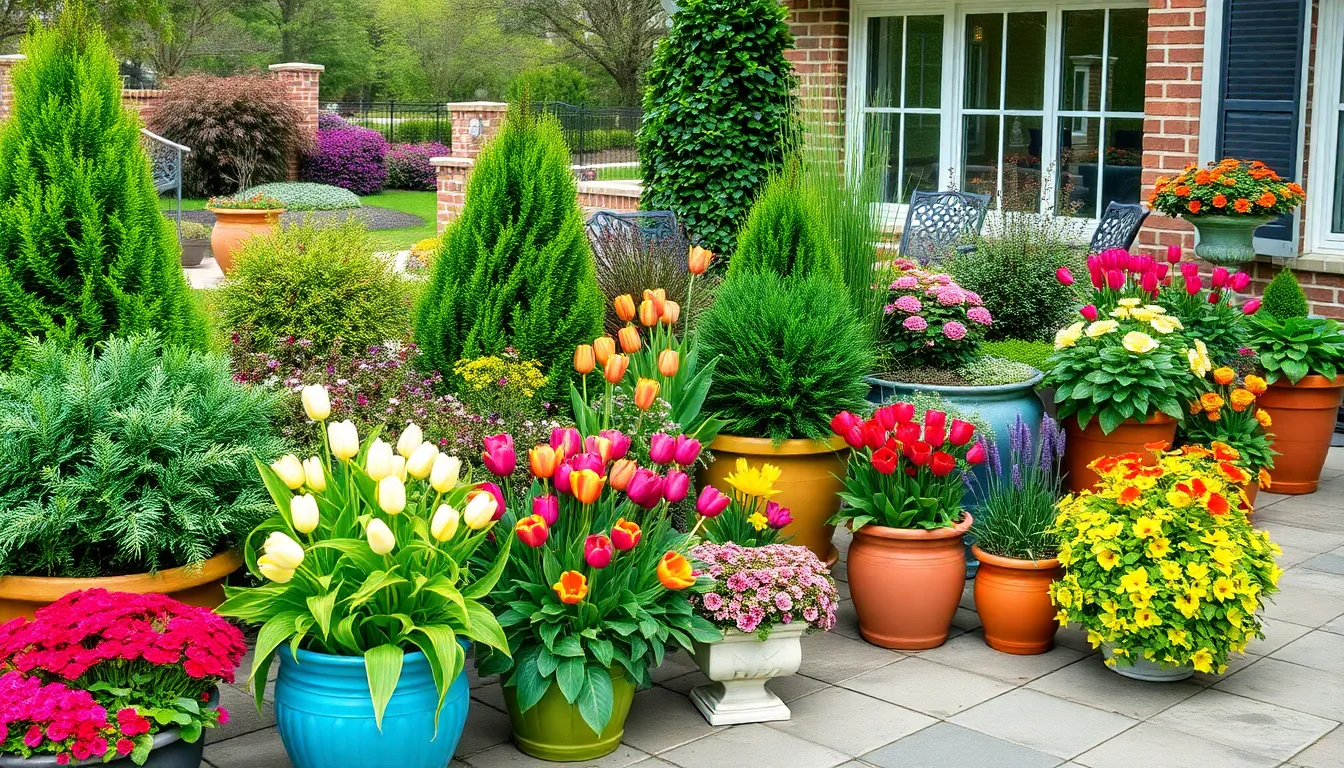
We’ve discussed how to maximize space and create zones on your patio with plants. Now let’s focus on ensuring your outdoor space remains vibrant and interesting throughout every season.
Include Evergreen Plants for Winter Appeal
Evergreens serve as the backbone of our patio gardens when other plants fade during colder months. These plants provide structure and maintain visual interest even when annuals go dormant. Boston ferns excel in container gardening and can deliver rich greenery lasting into late fall with proper care. We recommend positioning evergreen shrubs and conifers in larger containers at key focal points around your patio. Certain varieties thrive in containers and prevent our outdoor spaces from appearing bare during winter months. Strategic placement of these plants creates visual anchors that tie your entire patio design together year round.
Choose Plants with Different Seasonal Colors
Strategic plant selection ensures continuous color throughout the year by incorporating varieties that bloom or change foliage at different times. Spring brings vibrant possibilities with tulips in pots that provide bold color and can be changed annually to match your preferred palette. Summer annuals like Calibrachoa offer bright draping blooms in multiple colors and perform best in full sun locations. Fall introduces texture and warm tones through ornamental grasses and select perennials that showcase autumn hues.
Rex Begonias contribute shade loving colorful foliage rather than flowers and add unique color patterns when summer blooms begin to fade. Roses planted in large containers provide structure and fragrant flowers throughout much of the growing season while allowing for creative underplantings. We suggest combining different seasonal bloomers to create layers of interest that transition naturally from one season to the next.
Rotate Seasonal Containers and Displays
Container rotation keeps our patio spaces fresh and captivating throughout the year with minimal effort. We swap spring bulbs like tulips with summer annuals such as calibrachoa as seasons change. Transitioning to hardy grasses or evergreen plants for winter maintains visual appeal during dormant months. Hanging baskets provide instant seasonal charm and can be easily exchanged to reflect current growing conditions.
Planning seasonal rotations in advance helps us maintain continuous interest while managing our plant budget effectively. Storage areas for off season containers allow us to reuse favorite planters while extending their lifespan. Quick seasonal swaps transform the entire feel of our patio without requiring major redesign or important investment.
Conclusion
We’ve shown you how plants can completely transform your patio into a stunning outdoor retreat without very costly. From strategic container arrangements to living privacy screens and vertical gardens these plant-focused answers offer endless possibilities for any space size or budget.
The key to success lies in choosing plants that match your climate zone and maintenance preferences while creating defined zones and seasonal interest. By combining low-maintenance options with fragrant herbs and edible varieties you’ll enjoy both beauty and functionality throughout the year.
Your patio transformation starts with a single planter and grows from there. With these proven strategies you’re ready to create an outdoor sanctuary that reflects your personal style while providing a peaceful escape right outside your door.
Frequently Asked Questions
What plants are best for creating privacy on a small patio?
Fast-growing climbing plants like ivy, clematis, and climbing roses are ideal for creating privacy screens on small patios. These plants can be trained on trellises or support structures to provide immediate screening results. Combine different varieties to create a natural privacy gradient and layer plants by height for maximum coverage while maintaining visual appeal.
How do I choose the right container sizes for my patio plants?
Use large terra cotta or ceramic containers (18+ inches) for focal point plants and trees. Medium pots (12-16 inches) work well for flowering plants and shrubs. Small containers (6-10 inches) are perfect for herbs and compact varieties. Choose containers with proper drainage holes and group plants with similar water needs together for easier maintenance.
What are the most low-maintenance plants for patios?
Drought-tolerant plants like lantana, cacti, succulents, and lavender require minimal water and care. Choose perennials over annuals to reduce replanting efforts. Select plants suited to your specific climate zone and consider evergreens for year-round interest. These plants thrive with minimal attention while providing continuous beauty.
How can I create vertical gardens on my patio walls?
Install wall-mounted planters made from durable materials with proper drainage systems. Use a mix of different-sized planters to accommodate various plant types. Choose trailing plants like star jasmine, lantana, and sweet potato vine to add softness and movement. Group plants by color and texture for cohesive designs.
What edible plants work well in patio containers?
Herbs like basil, rosemary, and lavender are excellent in accessible containers near dining areas. Leafy greens, cherry tomatoes, and cucumbers grow well in medium to large planters. Consider dwarf fruit trees in large pots for seasonal production. Use raised bed systems for better organization and drainage of edible plants.
How do I incorporate fragrant plants into my patio design?
Place aromatic plants like star jasmine, English lavender, and fragrant herbs near seating areas and walkways to maximize sensory impact. Plan for seasonal blooming schedules with early spring bulbs, summer bloomers, and evergreen herbs to ensure continuous fragrance throughout the year. Group fragrant plants strategically to create inviting gathering spaces.
What’s the best way to frame my patio space with plants?
Use large statement plants like Croton Petra at corners to create structure and visual weight. Line walkways with decorative planters filled with aromatic plants to guide visitors. Create natural borders with layered plant arrangements and use climbing plants to define space boundaries while adding both beauty and function.
How can I ensure year-round interest in my patio garden?
Include evergreen plants for winter appeal and select varieties with different seasonal colors. Plan for rotating seasonal containers to keep displays fresh throughout the year. Combine early spring bulbs, summer bloomers, and plants with colorful fall foliage to maintain visual interest across all seasons.

